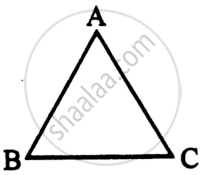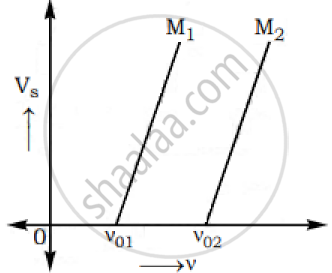Advertisements
Advertisements
प्रश्न
- Calculate the energy and momentum of a photon in a monochromatic beam of wavelength 331.5 nm.
- How fast should a hydrogen atom travel in order to have the same momentum as that of the photon in part (a)?
उत्तर
(a) Energy = E = `"hc"/λ`
or, E = `(6.6 xx 10^-34 xx 3 xx 10^8)/(331.5 xx 10^-9)`
∴ E = 6 × 10−19 J
Momentum = p = `"h"/λ`
Or, p = `(6.6 xx 10^-34)/(331.5 xx 10^-9)`
∴ p = 2 × 10−27 kg.m/s
(b) Momentum of Hydrogen atom = p = 2 × 10−27 kg.m/s
p = mv
Or, v = `"p"/"m"`
Or, v = `(2 xx 10^-27 "kg.m/s")/(1 "a.m.u")`
Or, v = `(2 xx 10^-27 "kg.m/s")/(1.66 xx 10^-27 "kg")`
∴ v = 1.2 m/s
संबंधित प्रश्न
Find the wave number of a photon having energy of 2.072 eV
Given : Charge on electron = 1.6 x 10-19 C,
Velocity of light in air = 3 x 108 m/s,
Planck’s constant = 6.63 x 10-34 J-s.
State two important properties of photon which are used to write Einstein’s photoelectric equation.
Define (i) stopping potential and (ii) threshold frequency, using Einstein’s equation and drawing necessary plot between relevant quantities.
Einstein's photoelectric equation is:
a) `E_"max" = hlambda - varphi_0`
b) `E_"max"= (hc)/lambda varphi_0`
c) `E_"max" = hv + varphi_0`
d) `E_"max" = (hv)/lambda + varphi_0`
According to the Einstein’s model, stopping potential Vo for a metal having work function ϕ0 is given by ______.
A police van moving on a highway with a speed of 30 km/h fires a bullet at a thief's car speeding away in the same direction with a speed of 192 km/h. If the muzzle speed of the bullet is 150 m is, with what speed does the bullet hit the thief's car?
In an inelastic collision, which of the following does not remain conserved?
(i) A ray of light incident on face AB of an equilateral glass prism, shows minimum deviation of 30°. Calculate the speed of light through the prism.

(ii) Find the angle of incidence at face AB so that the emergent ray grazes along the face AC.
- Calculate the frequency of a photon of energy 6.5 × 10−19 J.
- Can this photon cause the emission of an electron from the surface of Cs of work function 2.14 eV? If yes, what will be the maximum kinetic energy of the photoelectron?
The graphs below show the variation of the stopping potential VS with the frequency (ν) of the incident radiations for two different photosensitive materials M1 and M2.

Express work function for M1 and M2 in terms of Planck’s constant(h) and Threshold frequency and charge of the electron (e).
If the values of stopping potential for M1 and M2 are V1 and V2 respectively then show that the slope of the lines equals to `(V_1-V_2)/(V_(01)-V_(02))` for a frequency,
ν > ν02 and also ν > ν01
